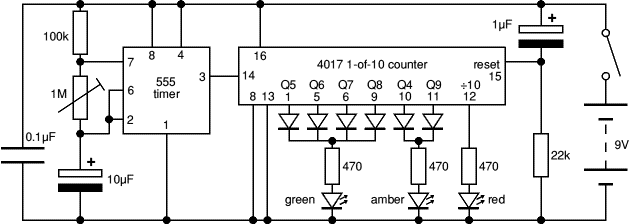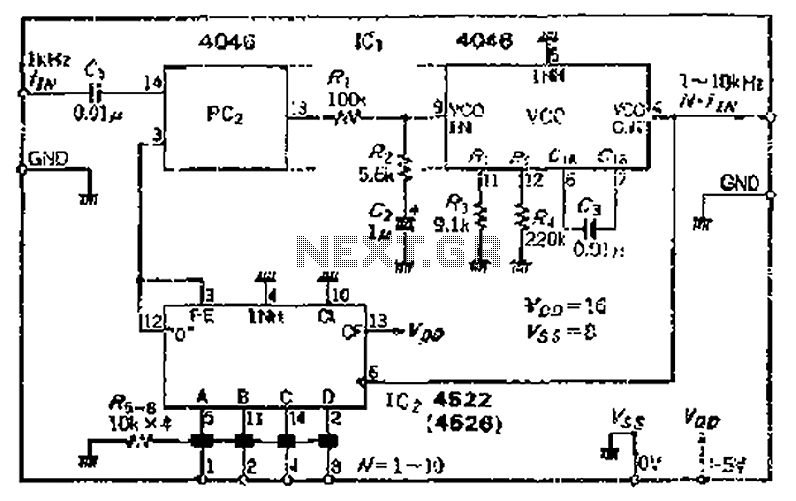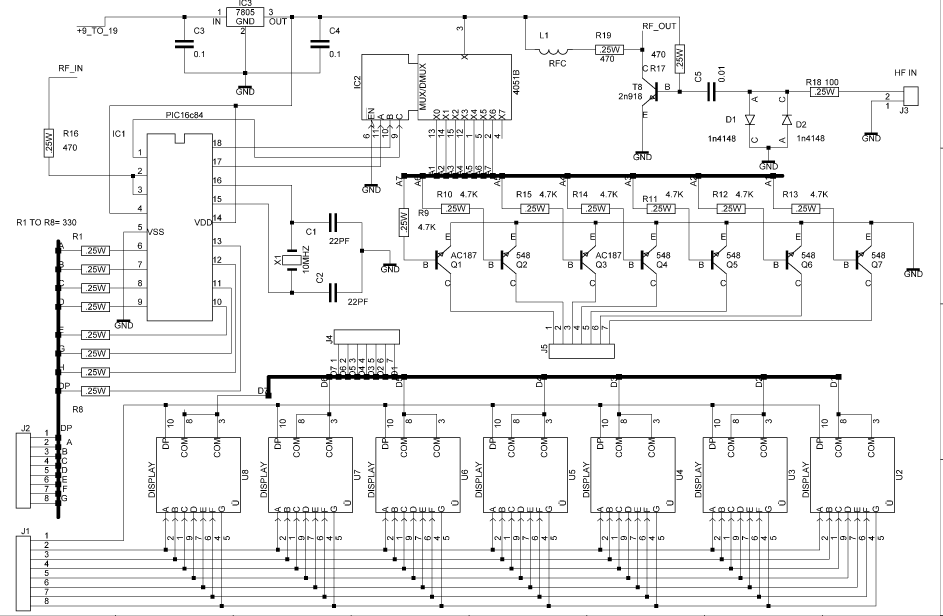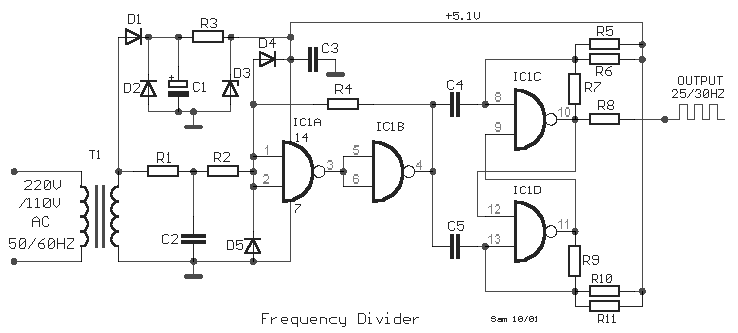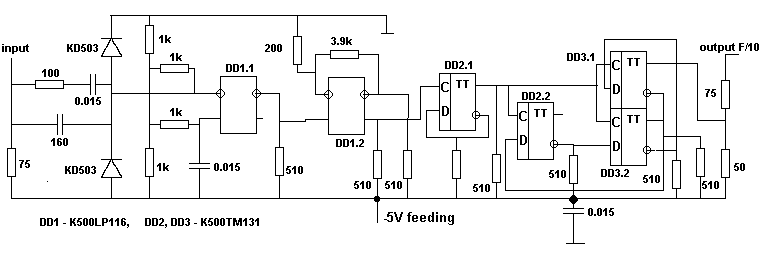
Frequency counter up to 1MHZ
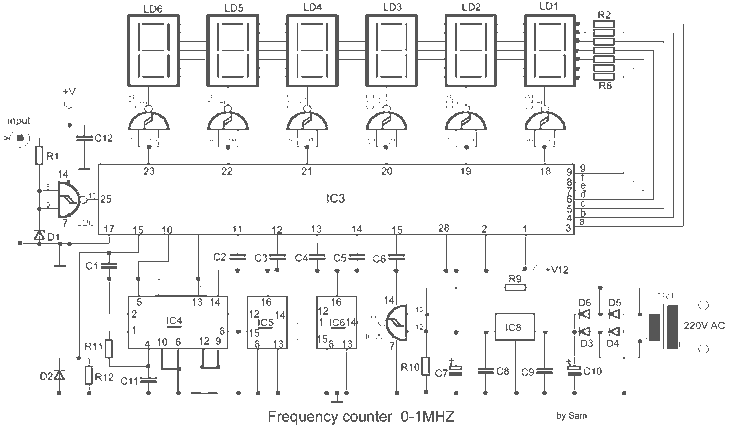
The MK50398 is one modern decimal counter up/down of six tens, with control of screen LED of seven segments and flip-flop of storage. Counter it can measure additive and abstractively. The IC MK50398 is ideal for manufacture frequency counter as the particular circuit. The frequency of measurement is from 0 HZ until roughly 1MHZ.
Part List
R1=10Kohm C4-5=150pF 100V IC1-2-4=4093
R2-8=1Kohm C7=47uF 25V IC3=MK50398
R9=8.2Kohm C8-9-12=100nF 100V IC5-6=4017
R10=10Kohm C10=1000uF 25V IC7=Not exist
R11=22Kohm C11= 470nF 100V IC8=7812
R12=10Kohm D1=12V 0.5W Zener TR1=220V-110Vac / 12V 0.5A
C1-6=1nF 100V D2=1N4148 .LD1-6 =7 segment Display Common Cathode
C2-3=150pF 100V D3-6=1N4002
The MK50398 integrated circuit functions as a modern decimal up/down counter capable of counting to six tens. It features a control mechanism for a seven-segment LED display and includes a flip-flop for data storage, allowing for both additive and subtractive counting operations. This versatility makes the MK50398 particularly suitable for applications such as frequency counters, where it can measure frequencies ranging from 0 Hz to approximately 1 MHz.
The circuit design incorporates various passive and active components to support the operation of the MK50398. Resistors R1 (10 kΩ), R2 to R8 (1 kΩ), R9 (8.2 kΩ), R10 (10 kΩ), R11 (22 kΩ), and R12 (10 kΩ) are employed to set biasing levels and control current flow within the circuit. Capacitors C1 to C6 (1 nF, 100 V), C2 and C3 (150 pF, 100 V), C4 and C5 (150 pF, 100 V), C7 (47 µF, 25 V), C8, C9, and C12 (100 nF, 100 V), C10 (1000 µF, 25 V), and C11 (470 nF, 100 V) are used for signal coupling, decoupling, and filtering to ensure stable operation and minimize noise.
The circuit utilizes several integrated circuits, including the 4093 (IC1-2-4), which is a quad NAND gate, and the 4017 (IC5-6), a decade counter. The MK50398 (IC3) serves as the primary counting element, while the 7812 voltage regulator (IC8) provides a stable 12 V supply for the circuit. The Zener diode (D1) regulates voltage, ensuring that the circuit operates within safe limits. Additional diodes, such as the 1N4148 (D2) and 1N4002 (D3-6), are included for protection and signal rectification.
The output from the MK50398 is displayed on a common cathode seven-segment display (LD1-6), which visually represents the counted value. The inclusion of a transformer (TR1) rated at 220V-110Vac / 12V 0.5A indicates the circuit's capability to operate from an AC mains supply, further enhancing its applicability in various electronic projects. The overall design of this circuit supports a wide range of counting applications, particularly in frequency measurement and digital display systems.The MK50398 is one modern decimal counter up/down of six tens, with control of screen LED of seven segments and flip-flop of storage. Counter it can measure additive and abstractively. The IC MK50398 is ideal for manufacture frequency counter as the particular circuit. The frequency of measurement is from 0 HZ until roughly 1MHZ. Part List R1=10Kohm C4-5=150pF 100V IC1-2-4=4093 R2-8=1Kohm C7=47uF 25V IC3=MK50398 R9=8.2Kohm C8-9-12=100nF 100V IC5-6=4017 R10=10Kohm C10=1000uF 25V IC7=Not exist R11=22Kohm C11= 470nF 100V IC8=7812 R12=10Kohm D1=12V 0.5W Zener TR1=220V-110Vac / 12V 0.5A C1-6=1nF 100V D2=1N4148 .LD1-6 =7 segment Display Common Cathode C2-3=150pF 100V D3-6=1N4002 🔗 External reference
Part List
R1=10Kohm C4-5=150pF 100V IC1-2-4=4093
R2-8=1Kohm C7=47uF 25V IC3=MK50398
R9=8.2Kohm C8-9-12=100nF 100V IC5-6=4017
R10=10Kohm C10=1000uF 25V IC7=Not exist
R11=22Kohm C11= 470nF 100V IC8=7812
R12=10Kohm D1=12V 0.5W Zener TR1=220V-110Vac / 12V 0.5A
C1-6=1nF 100V D2=1N4148 .LD1-6 =7 segment Display Common Cathode
C2-3=150pF 100V D3-6=1N4002
The MK50398 integrated circuit functions as a modern decimal up/down counter capable of counting to six tens. It features a control mechanism for a seven-segment LED display and includes a flip-flop for data storage, allowing for both additive and subtractive counting operations. This versatility makes the MK50398 particularly suitable for applications such as frequency counters, where it can measure frequencies ranging from 0 Hz to approximately 1 MHz.
The circuit design incorporates various passive and active components to support the operation of the MK50398. Resistors R1 (10 kΩ), R2 to R8 (1 kΩ), R9 (8.2 kΩ), R10 (10 kΩ), R11 (22 kΩ), and R12 (10 kΩ) are employed to set biasing levels and control current flow within the circuit. Capacitors C1 to C6 (1 nF, 100 V), C2 and C3 (150 pF, 100 V), C4 and C5 (150 pF, 100 V), C7 (47 µF, 25 V), C8, C9, and C12 (100 nF, 100 V), C10 (1000 µF, 25 V), and C11 (470 nF, 100 V) are used for signal coupling, decoupling, and filtering to ensure stable operation and minimize noise.
The circuit utilizes several integrated circuits, including the 4093 (IC1-2-4), which is a quad NAND gate, and the 4017 (IC5-6), a decade counter. The MK50398 (IC3) serves as the primary counting element, while the 7812 voltage regulator (IC8) provides a stable 12 V supply for the circuit. The Zener diode (D1) regulates voltage, ensuring that the circuit operates within safe limits. Additional diodes, such as the 1N4148 (D2) and 1N4002 (D3-6), are included for protection and signal rectification.
The output from the MK50398 is displayed on a common cathode seven-segment display (LD1-6), which visually represents the counted value. The inclusion of a transformer (TR1) rated at 220V-110Vac / 12V 0.5A indicates the circuit's capability to operate from an AC mains supply, further enhancing its applicability in various electronic projects. The overall design of this circuit supports a wide range of counting applications, particularly in frequency measurement and digital display systems.The MK50398 is one modern decimal counter up/down of six tens, with control of screen LED of seven segments and flip-flop of storage. Counter it can measure additive and abstractively. The IC MK50398 is ideal for manufacture frequency counter as the particular circuit. The frequency of measurement is from 0 HZ until roughly 1MHZ. Part List R1=10Kohm C4-5=150pF 100V IC1-2-4=4093 R2-8=1Kohm C7=47uF 25V IC3=MK50398 R9=8.2Kohm C8-9-12=100nF 100V IC5-6=4017 R10=10Kohm C10=1000uF 25V IC7=Not exist R11=22Kohm C11= 470nF 100V IC8=7812 R12=10Kohm D1=12V 0.5W Zener TR1=220V-110Vac / 12V 0.5A C1-6=1nF 100V D2=1N4148 .LD1-6 =7 segment Display Common Cathode C2-3=150pF 100V D3-6=1N4002 🔗 External reference
